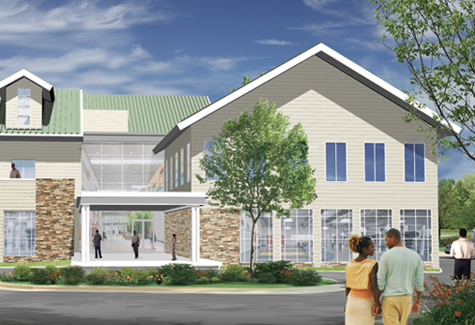Community center wins Regional Planning Council support

The Long Island Regional Planning Council has declared First Baptist Church of Riverhead’s long-planned Family Community Life Center as a project of regional significance, raising the project’s political standing and bettering its chances for grant money and donor interest.
The council is made up of 12 people, split between Nassau and Suffolk county residents, and offers advisory rulings on potential development projects — not on a village, town or county level, but a regional level. It has no regulatory power.
When First Baptist Church leaders first pitched their plans to the council in June, the council’s chairman, John Cameron, explained to a Newsday reporter that being deemed a project of regional significance wouldn’t necessarily mean the council endorses it, rather only that it meets certain criteria.
But in an interview with the News-Review last week, Mr. Cameron said the council is indeed “endorsing” the mixed-use project, which if built would consist of affordable — what’s also called workforce — rental housing, as well as recreational and educational facilities. The project, which has been in the works for at least the past 25 years, would require a zoning change to be built, something that failed to win approval late last year.
“This was one project that we really felt we can get behind; the council felt very strongly about it,” Mr. Cameron said, adding that one of its members is preparing to visit the Riverhead Town Board to explain how the council reached its decision. “It’s not only an economic development project, but it’s going to create affordable housing in an area where it’s absolutely needed. The rental housing and affordable aspect resonated strongly with the council.”
Council members also took potential tax implications very seriously, since the project would be built on church property and therefore be tax exempt, he said.
Shirley Coverdale, president and CEO of the nonprofit Family Community Life Center, Inc., said that, among other points, she explained to the council that such an arrangement is not unique.
“If one were to look at properties held and developed by the Catholic Church or the Lutheran Church or the Episcopal Church, the holdings amount to in the billions of dollars, and many of them have been used for housing developments and community centers and other such things, so this is not at all unique,” she said.
The rental income and other means of raising money — such as government grants, fundraisers, and investment tax credits — would help make the project’s classrooms, computer rooms, elder care facility, gymnasium, swimming pool, and fitness center “available to the largest number of people in the community,” Ms. Coverdale said.
“They said we’re absolutely paying taxes; we’re bearing the costs of providing these services to the town,” she said.
The Town Board has had differing opinions on the proposal.
Supervisor Sean Walter, who was appointed to the planning council in 2011, has been a staunch supporter of the Family Community Life Center proposal.
Among its chief critics, however, is Councilwoman Jodi Giglio, who raises several concerns whenever discussing the project. Chief among them is the fact that the church-owned property would be tax-exempt.
Under the current proposal, 100 one-bedroom and 25 two-bedroom apartments would be built.
“I think it’s a great project, but I think it’s over-intensified for that area,” she said. “And it shouldn’t be nonprofit in perpetuity.”
A developer herself, Ms. Giglio said she was “a little surprised” the council decided as it did, “knowing it’s not in a downtown and they’d have to tie into the sewers,” she said. “You’d think they’d favor projects close to downtowns where people don’t need cars.”
She also said no such development is mentioned in the town’s comprehensive master plan.
Though it’s not in a downtown area, Ms. Coverdale said planning council members recognized that those living at the center could catch a bus to downtown or Route 58 to work, or take a car to and from work without having to use the Long Island Expressway.
“It’s not just young people; it’s retirees, too,” she added. “Especially as we get up in years, we’re more likely to have a major part of our income go toward the support and maintenance of our health care. All you need is one catastrophic illness or loss of a spouse to make a single-family home something that you’re no longer interested in or able to maintain or afford. Diversifying the housing stock and housing alternatives is something the council is very interested in.”
Mr. Walter said he hopes to discuss the Family Community Life Center with the rest of the Town Board in the “not-so-distant future.”
“There’s always hope,” Mr. Walter said, hinting that he had some ideas that might help allay some concerns among the board. “The council recognizes that Long Island is in desperate need of workforce housing, that we lag behind the rest of the country. A lot of people in their 20s don’t have the opportunity to move into a Summerwind [workforce housing downtown]. So they have to move into an attic or a basement [apartment] somewhere; this provides a good opportunity for those folk. And when you tie it to things like development at [the Enterprise Park at Calverton], there’s going to be an even greater demand for workforce housing.
“That, combined with the pool, gym and fitness center along the lines of the YMCA — it’s a worthy project,” he said.


